The Yeti Crab: A Fascinating Deep-Sea Marvel
The Yeti Crab, scientifically known as Kiwa hirsuta, is a species of crustacean that was discovered in 2005 during a deep-sea expedition near hydrothermal vents in the Pacific Ocean.
It belongs to the family Kiwaidae and is often referred to as the “Yeti Crab” due to its characteristic appearance, which resembles the mythical creature known as the Yeti or Abominable Snowman.
The Yeti Crab is notable for its unique features and adaptations to its extreme deep-sea habitat. It has a hairy appearance, with long setae (bristle-like structures) covering its body and claws.
These setae are believed to play a role in providing a habitat for bacteria, which the crab may cultivate for nutritional purposes. The bacteria are thought to utilize the chemical compounds emitted by the hydrothermal vents.
Unlike many other crabs, the Yeti Crab does not have pincers or sharp claws. Instead, it has specialized comb-like appendages on its third pair of legs that it uses for filter-feeding. These appendages have small, hair-like structures that help the crab capture tiny organisms and particles from the water, allowing it to feed on the bacteria and organic matter present in its environment.
| Taxonomic Rank | Classification |
|---|---|
| Kingdom | Animalia |
| Phylum | Arthropoda |
| Subphylum | Crustacea |
| Class | Malacostraca |
| Order | Decapoda |
| Suborder | Pleocyemata |
| Infraorder | Anomura |
| Family | Kiwaidae |
| Genus | Kiwa |
| Species | K. hirsuta |
| Binomial name | Kiwa hirsuta Macpherson, Jones & Segonzac, 2006 |
The Fascinating Appearance of the Yeti Crab
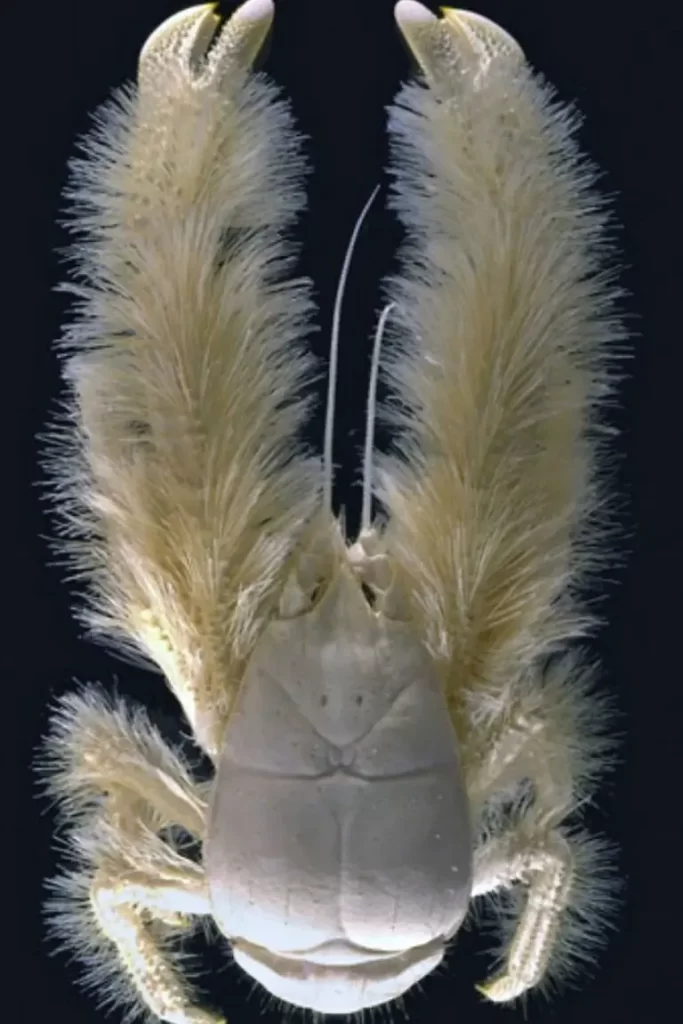
The Yeti Crab, also known as Kiwa hirsuta, is an extraordinary creature that captivates scientists and nature enthusiasts alike with its unique and intriguing appearance. Let’s delve into the fascinating details of its distinctive features and understand what makes this crustacean so remarkable.
Shaggy and Fluffy: The Hair-Like Setae
One of the most striking characteristics of the Yeti Crab is its shaggy and fluffy appearance. The entire body of the crab is covered in long, hair-like structures called setae.
These setae, which are actually bristles or filaments, give the crab its distinct resemblance to the legendary Yeti or Abominable Snowman.
The setae are densely packed, creating a fluffy and woolly texture that sets the Yeti Crab apart from its smoother-shelled relatives.
A Functional Purpose: Symbiotic Relationship with Bacteria
While the shaggy setae of the Yeti Crab may seem like a mere aesthetic feature, they serve a crucial purpose in the crab’s survival.
These setae provide a unique habitat for bacteria to thrive. The bacteria form a symbiotic relationship with the crab, benefiting both parties.
The bacteria living in the setae are believed to play a vital role in the crab’s nutrition. They are specialized in processing the chemical compounds emitted from the hydrothermal vents where the Yeti Crab resides. These vents release hot, mineral-rich fluids into the deep-sea environment.
The bacteria in the setae are capable of converting these chemicals into a form that the crab can use as a source of nutrition.
Adapted for Deep-Sea Life: Hydrothermal Vent Dwellers
The Yeti Crab is found in the deep-sea environments near hydrothermal vents, which are fissures in the ocean floor that release superheated water and mineral-rich substances.
These vents create a unique habitat that is challenging for most organisms to survive in due to the extreme conditions of high pressure, darkness, and temperature fluctuations.
The Yeti Crab has evolved remarkable adaptations to thrive in this harsh environment. Its distinctive setae not only provide a home for beneficial bacteria but also help the crab trap organic particles and minerals from the surrounding water, serving as a sort of filter-feeding mechanism.
A New Species and Ongoing Research
The discovery of the Yeti Crab in 2005 was a significant milestone in deep-sea exploration. Since then, scientists have continued to study these mysterious creatures to unravel more about their biology, behavior, and ecological significance.
Research efforts have shed light on the unique adaptations and symbiotic relationships that enable the Yeti Crab to survive in such extreme conditions.
The Origins of the Yeti Crab’s Name
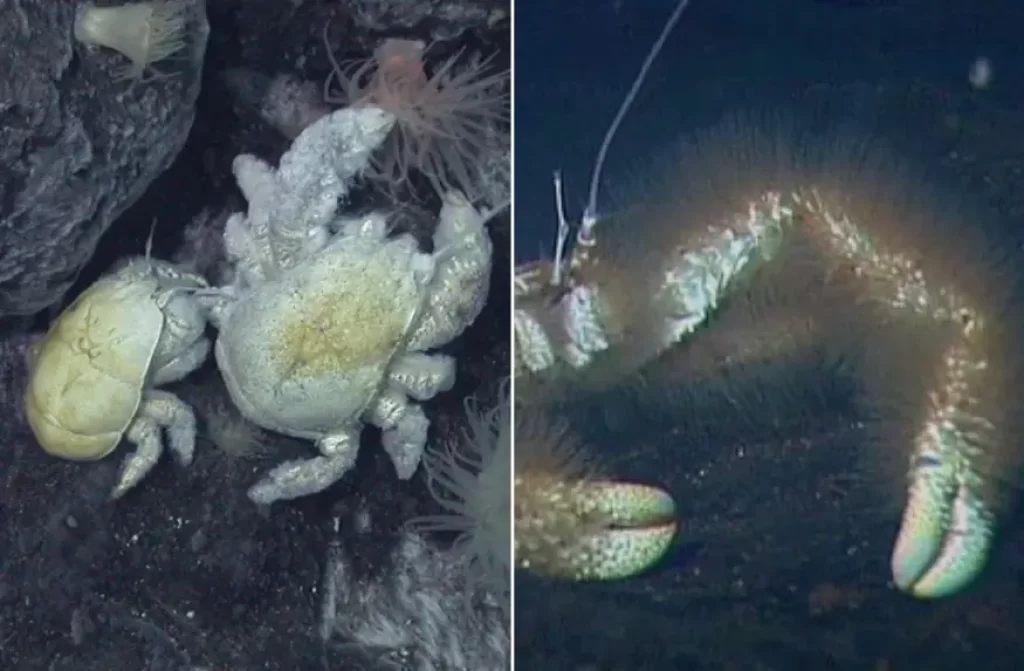
The Yeti Crab, also scientifically known as Kiwa hirsuta, derives its popular name from the resemblance it bears to the legendary creature known as the Yeti or Abominable Snowman.
The name “Yeti” has long been associated with a mythical, hairy creature said to inhabit the remote and snowy regions of the Himalayas.
When scientists first discovered the Yeti Crab in 2005 during an expedition to the Pacific-Antarctic Ridge, they were immediately struck by its remarkable appearance. The crab’s body, covered in long, hair-like setae, seemed to mimic the shaggy fur of the legendary Yeti.
This uncanny resemblance led to the adoption of the name “Yeti Crab” as a popular and memorable moniker for this intriguing species.
The choice of the name “Yeti Crab” not only captures the crab’s visual similarity to the legendary creature but also adds an air of mystery and intrigue to its scientific identification. It invokes a sense of wonder and curiosity, highlighting the extraordinary nature of this newly discovered species.
It’s important to note that the scientific community officially recognizes the Yeti Crab by its scientific name, Kiwa hirsuta, which refers to the genus Kiwa (named after the mythological goddess of shellfish in Polynesian culture) and the species descriptor “hirsuta,” meaning hairy.
However, the popular name “Yeti Crab” has become widely embraced and serves as a captivating and easily recognizable term for this enigmatic deep-sea dweller.
The Size of a Typical Yeti Crab
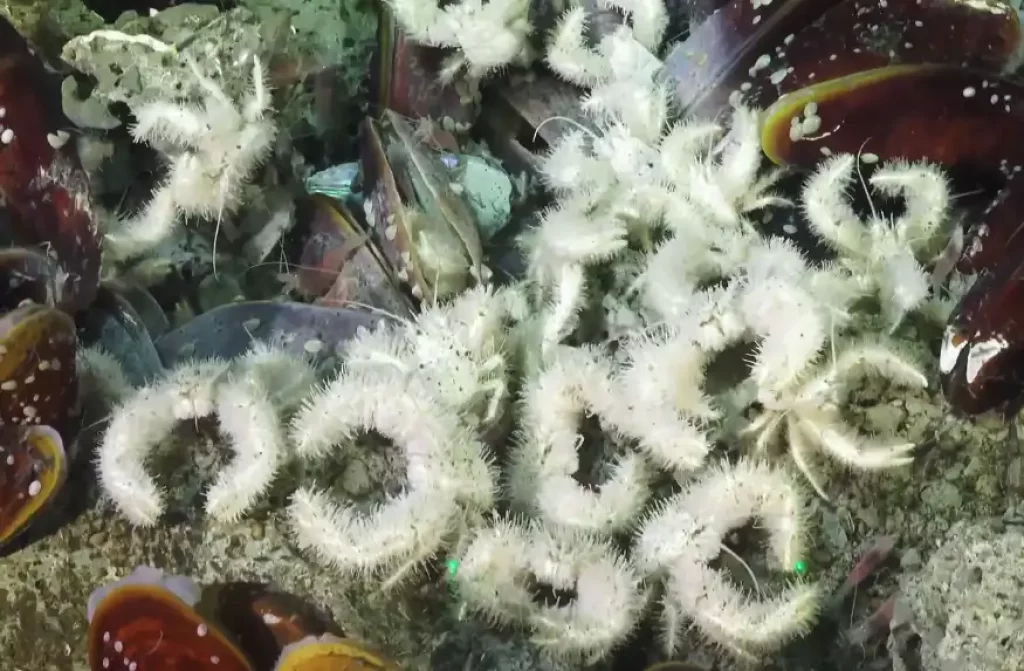
The Yeti Crab, also known as the “furry lobster” or “Yeti lobster,” is a fascinating deep-sea crustacean that inhabits hydrothermal vents and cold seeps in the oceans. These unique creatures have captured the attention of scientists and marine enthusiasts due to their distinct appearance and intriguing adaptations. One aspect of the Yeti Crab’s biology that piques curiosity is its size. Let’s delve deeper into the size range of these remarkable creatures and the factors that influence their dimensions.
Size Variation among Yeti Crab Species
The Yeti Crab family (Kiwa) consists of several known species, each with its own size characteristics. The most well-known species, Kiwa hirsuta, exhibits an average size of 15 to 20 centimeters (6 to 8 inches) in length.
However, it’s important to note that within this size range, individual specimens can still exhibit variations in size.
Factors Influencing Size
Several factors contribute to the size variations observed among Yeti Crabs. These include genetics, environmental conditions, and resource availability.
Genetic factors play a role in determining the potential size range of a species, while environmental conditions, such as water temperature and pressure, can influence growth rates and overall size. Additionally, the availability of food sources in their habitat can impact the size that individuals can attain.
Size-Related Adaptations
The size of the Yeti Crab is intricately linked to its adaptations for survival in its unique habitat. Their elongated limbs, covered in hair-like setae, provide a larger surface area for nutrient absorption from chemosynthetic bacteria on their bodies.
This adaptation enables them to extract energy from the chemically rich fluids emitted by hydrothermal vents and cold seeps.
The size of their appendages and body structure is optimized for efficient filter-feeding and scavenging, allowing them to make the most of the available resources in their extreme environment.
Size Records and Variations
While the average size range for the Yeti Crab is around 15 to 20 centimeters, there have been notable records of larger individuals. In some cases, specimens measuring up to 30 centimeters (12 inches) in length have been observed.
These larger individuals may have access to more abundant food resources or may belong to specific populations with genetic variations that allow for greater growth potential.
The Diet of the Yeti Crab

The Yeti Crab, also known as the “furry lobster” or “Yeti lobster,” is a peculiar deep-sea crustacean that inhabits hydrothermal vents and cold seeps. These unique creatures have adapted to survive in extreme environments where conventional food sources are scarce.
Understanding the diet of the Yeti Crab is essential to unraveling its ecological role and the fascinating strategies it employs to obtain nutrients.
Chemosynthetic Bacteria as a Primary Food Source
One of the remarkable aspects of the Yeti Crab’s diet is its reliance on chemosynthetic bacteria for sustenance. These bacteria form symbiotic relationships with the crab, residing on specialized filamentous structures called setae found on its limbs.
The bacteria convert chemicals, such as hydrogen sulfide and methane, into organic matter through a process known as chemosynthesis. The Yeti Crab derives its nutrition by consuming the bacterial colonies that thrive on its setae.
Filter-Feeding and Detritus Consumption
In addition to their reliance on chemosynthetic bacteria, Yeti Crabs are opportunistic filter-feeders and scavengers.
They use their modified appendages and setae to filter out organic particles, detritus, and small organisms suspended in the water column.
This behavior allows them to capture and consume microscopic food particles, such as plankton, algae, and decaying matter, that may be present in their deep-sea environment.
Adaptations for Efficient Feeding
The morphology and structure of the Yeti Crab’s appendages are adapted to facilitate efficient feeding. Their elongated, bristle-covered limbs provide a larger surface area for filter-feeding and capturing food particles. T
he setae on their appendages trap small organic matter, which is then brought closer to the mouth for ingestion.
This adaptation allows the Yeti Crab to maximize its nutrient intake from the limited food resources available in its habitat.
Feeding Strategies in Extreme Environments
Hydrothermal vents and cold seeps, the habitats of Yeti Crabs, are characterized by extreme conditions, including high pressure, darkness, and limited food availability.
The ability of these crabs to thrive in such environments is a testament to their unique feeding strategies.
By relying on chemosynthetic bacteria and adopting filter-feeding behaviors, they have adapted to extract energy from the chemically rich fluids and organic particles present in their surroundings.
Adaptations of the Yeti Crab to the Deep-Sea Environment
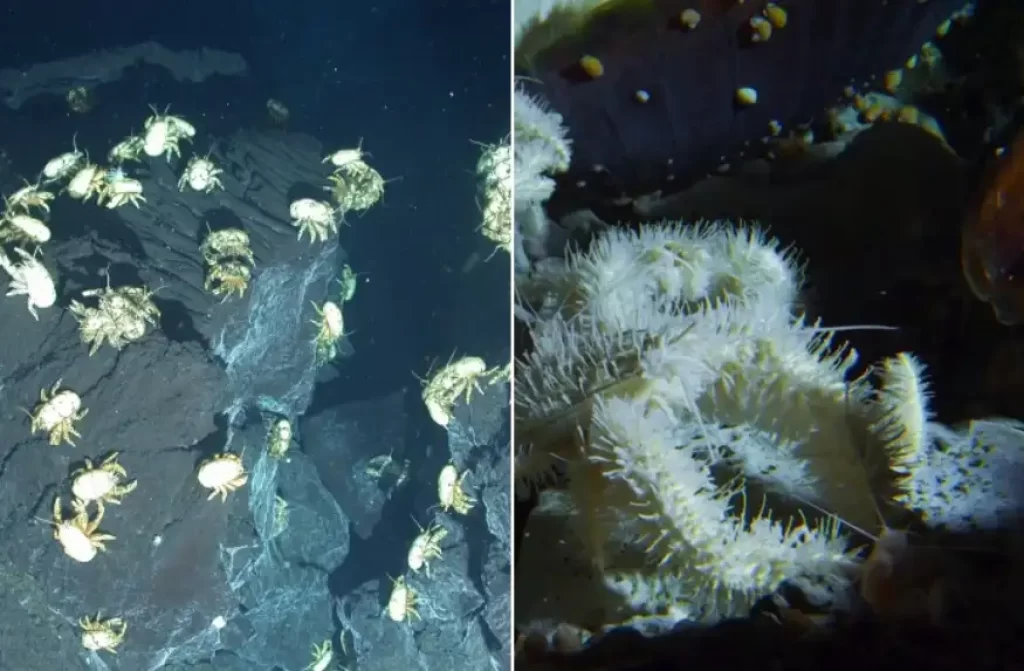
The Yeti Crab is an extraordinary creature that has successfully adapted to the unique challenges posed by its deep-sea habitat. To thrive in the harsh conditions of the deep-sea environment, the Yeti Crab has developed remarkable physiological and behavioral adaptations that enable it to survive and reproduce. These adaptations are essential for its survival in a world of perpetual darkness, extreme pressure, and limited food availability.
Thermal Tolerance
One of the primary challenges faced by deep-sea organisms is the extreme temperature fluctuations in their environment. The Yeti Crab has evolved thermal tolerance mechanisms that allow it to withstand the varying temperatures near hydrothermal vents and cold seeps.
These habitats experience hot water discharges and can reach temperatures of up to 400°C (752°F).
The Yeti Crab possesses specialized proteins and enzymes that provide thermal stability, protecting its cellular functions from heat stress.
Pressure Resistance
The deep-sea environment is characterized by immense water pressure due to the depth at which these organisms reside.
The Yeti Crab has adaptations to withstand the extreme pressure found at the depths where it lives. Its exoskeleton, composed of a rigid cuticle, provides structural support and protection against the crushing pressure.
Additionally, the Yeti Crab’s internal body cavities contain fluid that helps balance the external pressure, preventing collapse and damage to its vital organs.
Bioluminescence
In the absence of sunlight, deep-sea organisms often rely on bioluminescence for communication, predation, and mating purposes. The Yeti Crab possesses specialized light-producing organs called photophores, which emit a faint glow.
This bioluminescence serves various functions, including attracting potential mates, warning off predators, or luring prey. The ability to produce light enhances the Yeti Crab’s survival and communication in the dark depths of the ocean.
Adapted Sensory Organs
Living in perpetual darkness, the Yeti Crab has adapted its sensory organs to navigate and locate food sources.
It possesses elongated antennae and modified appendages that serve as sensory structures, enabling it to detect chemical cues and vibrations in its environment.
These adaptations allow the Yeti Crab to locate potential mates, identify food sources, and avoid predators in the deep-sea ecosystem.
Predators of the Yeti Crab
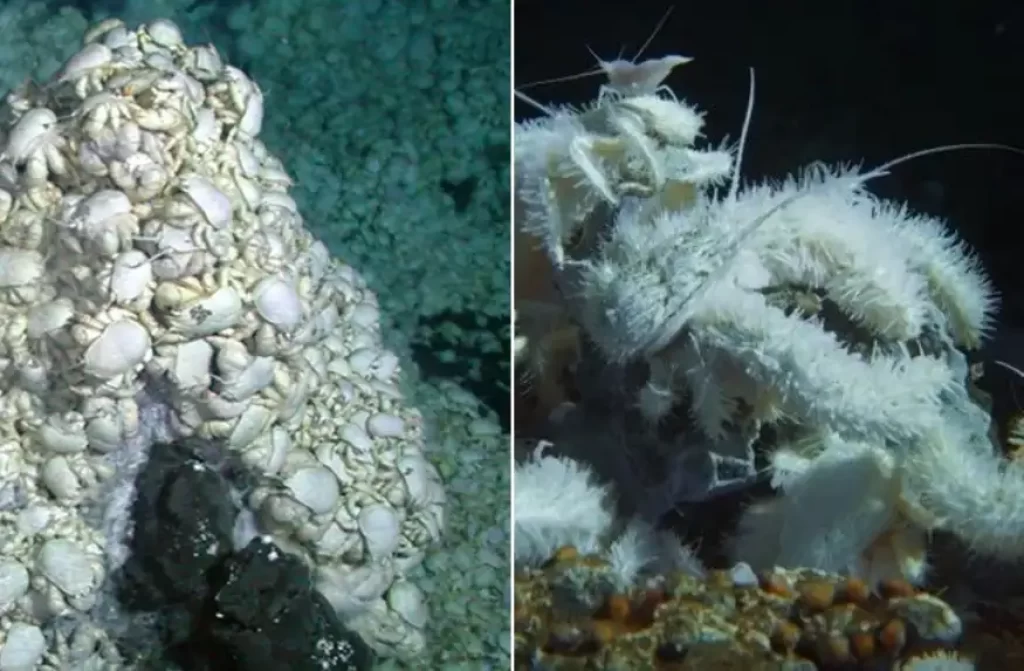
Despite its unique appearance and adaptations, the Yeti Crab is not immune to predation in its deep-sea habitat. Like many organisms, the Yeti Crab has natural predators that pose a threat to its survival. These predators are also adapted to the harsh conditions of the deep sea and have evolved mechanisms to capture and consume their prey efficiently.
King Crabs
One of the primary predators of the Yeti Crab is the larger and more aggressive king crabs. King crabs, such as the Alaskan king crab, are known to inhabit the same deep-sea regions as the Yeti Crab.
They have powerful claws that they use to catch and crush their prey. If a Yeti Crab encounters a king crab, it may become a target for predation.
Fish
Several species of deep-sea fish are potential predators of the Yeti Crab. These fish, such as grenadiers and rattails, are adapted to life in the deep sea and possess specialized jaws and teeth for capturing and consuming prey.
They have well-developed senses, including an acute sense of smell and the ability to detect prey through vibrations and bioluminescent signals. If a Yeti Crab ventures into the path of a hungry deep-sea fish, it becomes vulnerable to predation.
Other Crustaceans
Within the deep-sea ecosystem, there are various crustaceans that can be potential predators of the Yeti Crab. These include larger shrimp-like crustaceans and other decapods.
While the Yeti Crab possesses its own set of adaptations and defenses, encounters with larger and more aggressive crustaceans can still result in predation.
Cephalopods
Certain cephalopods, such as deep-sea squid and octopuses, may also prey on the Yeti Crab. These highly intelligent and agile creatures are skilled hunters and possess sharp beaks and tentacles for capturing and immobilizing their prey. If a Yeti Crab is within their hunting range, it can become a target for these cephalopods.
Reproductive Strategies of the Yeti Crab
The Yeti Crab, known for its unique appearance and adaptations, also possesses fascinating reproductive strategies to ensure the survival and proliferation of its species in the challenging deep-sea environment.
Let’s explore how these intriguing creatures reproduce and pass on their genetic legacy.
Sexual Reproduction
The Yeti Crab follows a typical pattern of sexual reproduction. Males and females of the species engage in a complex courtship ritual to facilitate successful mating.
The exact details of the courtship behavior in Yeti Crabs are not extensively studied due to their deep-sea habitat, but observations have revealed certain behaviors common in other crustacean species.
Mating Behavior
Male Yeti Crabs often compete for the attention of females through displays of strength or dominance. This can involve waving their pincers, extending specialized appendages, or engaging in aggressive encounters.
Once a male successfully attracts a female, they engage in a mating ritual that may involve touching, grasping, or other physical interactions.
Fertilization
After mating, the female Yeti Crab carries fertilized eggs, which she incubates and protects until they hatch.
The exact duration of the incubation period is not well-documented, but it is believed to last for several months.
During this time, the female carefully tends to the eggs, providing them with necessary nutrients and ensuring their survival.
Larval Development
Once the eggs hatch, the Yeti Crab larvae emerge into the water column. These larvae are planktonic and drift with the ocean currents, undergoing a series of developmental stages.
As they grow, they undergo molting, shedding their exoskeleton to accommodate their increasing size. This process continues until they reach adulthood.
Settlement
As the Yeti Crab larvae mature, they eventually settle on the ocean floor, seeking a suitable habitat to establish themselves as independent individuals.
The young crabs search for appropriate substrate, such as hydrothermal vents or cold seeps, where they can find food and shelter to support their survival and growth.
The Ecological Role of the Yeti Crab
The Yeti Crab, with its remarkable adaptations and presence in the deep-sea environment, plays a crucial role in its ecosystem. As a specialized species, it contributes to the intricate web of interactions and functions that sustain the delicate balance of deep-sea ecosystems.
Let’s explore the ecological role of the Yeti Crab and its significance in these unique environments.
Hydrothermal Vent and Cold Seep Communities
The Yeti Crab is primarily found in hydrothermal vent and cold seep communities, which are extreme and chemically rich environments. These habitats support diverse communities of organisms, often with high levels of endemism. The Yeti Crab’s presence in these communities influences the dynamics and structure of these ecosystems.
Biological Interactions:
The Yeti Crab engages in various biological interactions, which further shape its ecological role. These interactions include:
A. Symbiotic Relationships: The Yeti Crab hosts symbiotic bacteria on its hairy appendages, which are thought to provide nutrition through chemosynthesis. This mutualistic association benefits both the crab and the bacteria, contributing to the energy flow within the ecosystem.
B. Habitat Modification: Yeti Crabs can modify their surrounding habitat through their foraging and burrowing activities. By creating burrows, they contribute to the physical structure of the seafloor, potentially providing shelter for other organisms.
C. Trophic Interactions: The Yeti Crab is an omnivorous species, feeding on various food sources, including organic matter, bacteria, and potentially other small organisms. By consuming and recycling organic material, the crab plays a role in nutrient cycling and energy transfer within the ecosystem.
Biodiversity and Connectivity
As a keystone species, the Yeti Crab influences the diversity and connectivity of deep-sea ecosystems. Its presence provides niches and resources for other organisms, promoting biodiversity in these extreme environments. Additionally, the mobility of the Yeti Crab and its potential to disperse across different vent and seep sites may contribute to genetic connectivity and gene flow among populations.
Scientific Research
The Yeti Crab has drawn significant scientific interest due to its unique adaptations and association with hydrothermal vents and cold seeps. Research on the ecology and biology of the Yeti Crab provides insights into the functioning of deep-sea ecosystems, as well as the evolution and adaptation of organisms to extreme conditions.
Have any other species similar to the Yeti Crab been discovered?
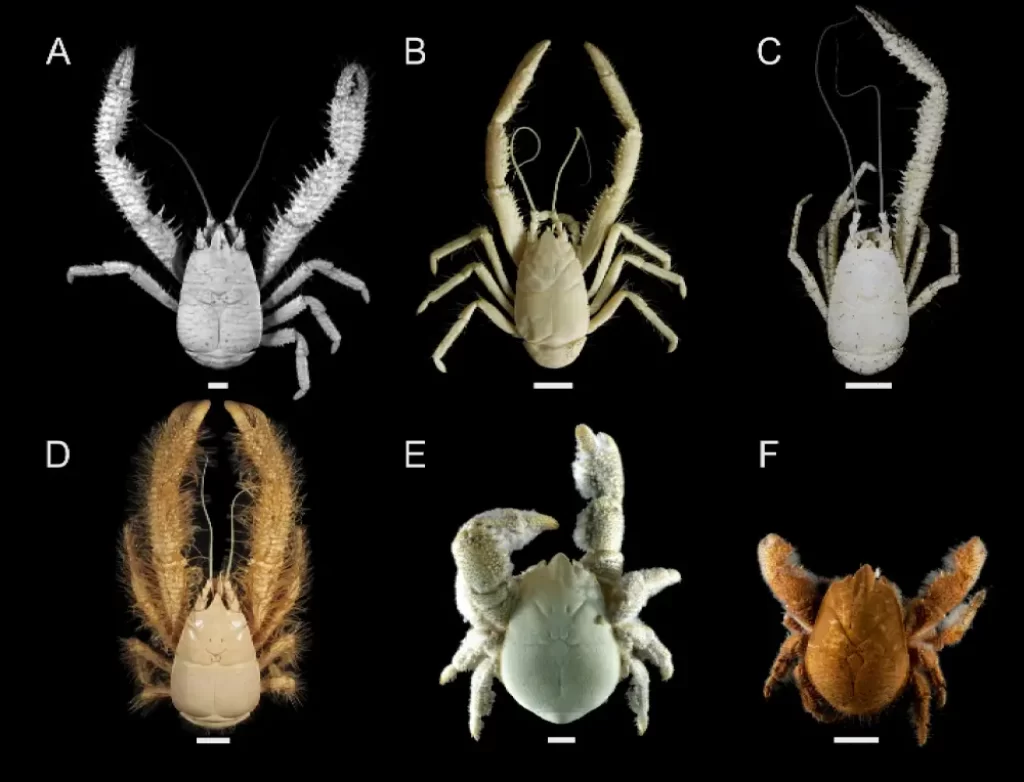
The Yeti Crab (Kiwa hirsuta) has captivated scientists and the public alike with its unique appearance and adaptations to the deep-sea environment. While the Yeti Crab remains the most famous species of its kind, several other fascinating organisms with similar characteristics have been discovered in the deep ocean. Let’s delve into the intriguing world of these Yeti Crab relatives and learn more about their remarkable adaptations.
Kiwa puravida: The Costa Rican Yeti Crab
In 2011, off the coast of Costa Rica, scientists made an exciting discovery: the Kiwa puravida, also known as the “Costa Rican Yeti Crab.”
This species shares striking similarities with the original Yeti Crab. It possesses a hairy appearance, with dense bristles covering its body, and is typically found in hydrothermal vent ecosystems.
The Costa Rican Yeti Crab’s discovery expanded our understanding of the distribution and diversity of these remarkable creatures.
Kiwa tyleri: The Hoff Crab
In 2010, Kiwa tyleri, commonly known as the “Hoff Crab,” was found near Antarctica in the Southern Ocean. Named in honor of marine biologist Richard Hoff, this species exhibits similar adaptations to the Yeti Crab. It boasts a dense covering of setae or hair-like structures on its body and possesses long, powerful pincers.
The Hoff Crab thrives in the frigid waters of the Southern Ocean, showcasing its ability to adapt to extreme cold seep environments.
Kiwa n. sp.: Unveiling New Species
In addition to the described species, ongoing deep-sea exploration continues to reveal yet-to-be-named species of Kiwa crabs.
These newly discovered organisms exhibit variations in their morphology and adaptations, further expanding our understanding of the diversity within the Kiwaidae family.
Each new finding provides valuable insights into the evolutionary history and ecological roles of these intriguing deep-sea creatures.
Diving Deeper: Unlocking the Secrets of Yeti Crab Relatives
The discovery of these similar species to the Yeti Crab highlights the remarkable adaptability of organisms in the deep-sea environment.
They have evolved specialized features that enable them to thrive in the extreme conditions of hydrothermal vents and cold seeps, where darkness, high pressure, and nutrient-rich fluids shape their existence.
Studying these Yeti Crab relatives provides valuable information about the ecology, physiology, and biodiversity of deep-sea ecosystems. It sheds light on the interconnectedness and intricate web of life that exists in the depths, where unique adaptations are necessary for survival.
FAQ
How does the yeti crab obtain its food?
The Yeti Crab obtains its food through filter feeding and scavenging. It uses its hairy appendages to collect tiny particles from the water and also feeds on decaying organic matter and small invertebrates found on the seafloor.
Where does the yeti crab come from?
The Yeti Crab is primarily found in the deep-sea hydrothermal vents of the Pacific Ocean, particularly in the vicinity of Easter Island and other areas of the South Pacific. These hydrothermal vents provide the unique environmental conditions that the Yeti Crab requires to thrive.
What did yeti crabs evolve from?
Yeti crabs are believed to have evolved from a common ancestor shared with other crustaceans, specifically within the group of squat lobsters. They have developed unique adaptations over time to thrive in the deep-sea hydrothermal vent environments. The exact evolutionary history and relationships of yeti crabs are still subjects of ongoing scientific research and study.
Can we eat yeti crab?
Yeti crabs are not typically consumed as food by humans. Their specialized habitat and unique adaptations make them unsuitable for commercial fishing or culinary purposes. Furthermore, their populations are often found in remote and deep-sea locations, making it challenging to obtain them for consumption.
Additionally, conservation efforts and regulations are in place to protect deep-sea ecosystems and their inhabitants, including yeti crabs. Therefore, it is generally discouraged to consume yeti crabs and they are primarily valued for their ecological significance and scientific interest rather than their potential as a food source







